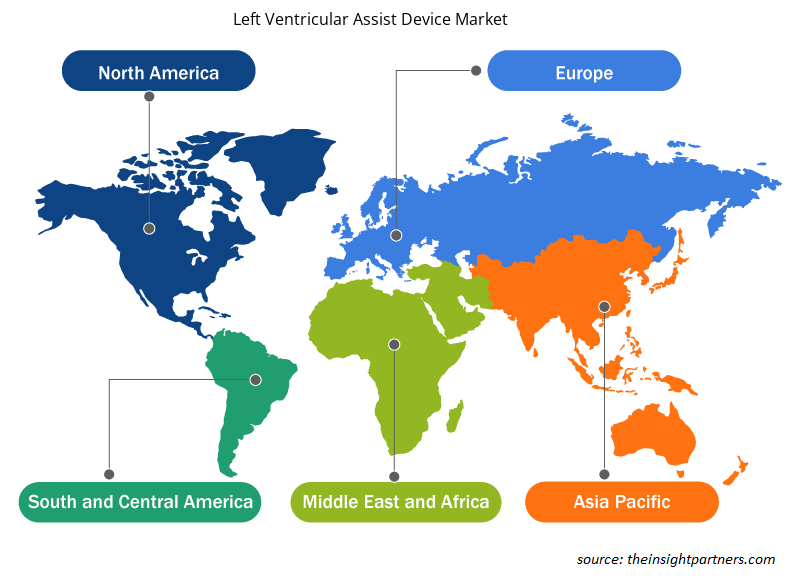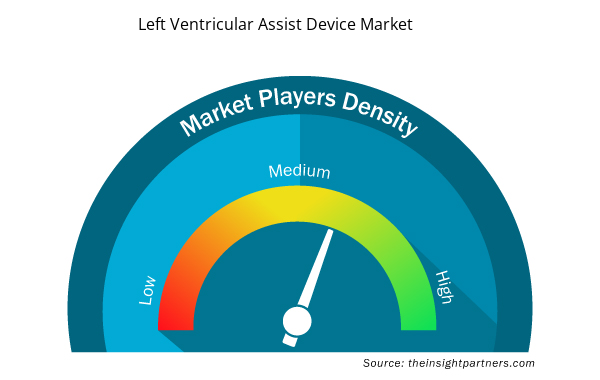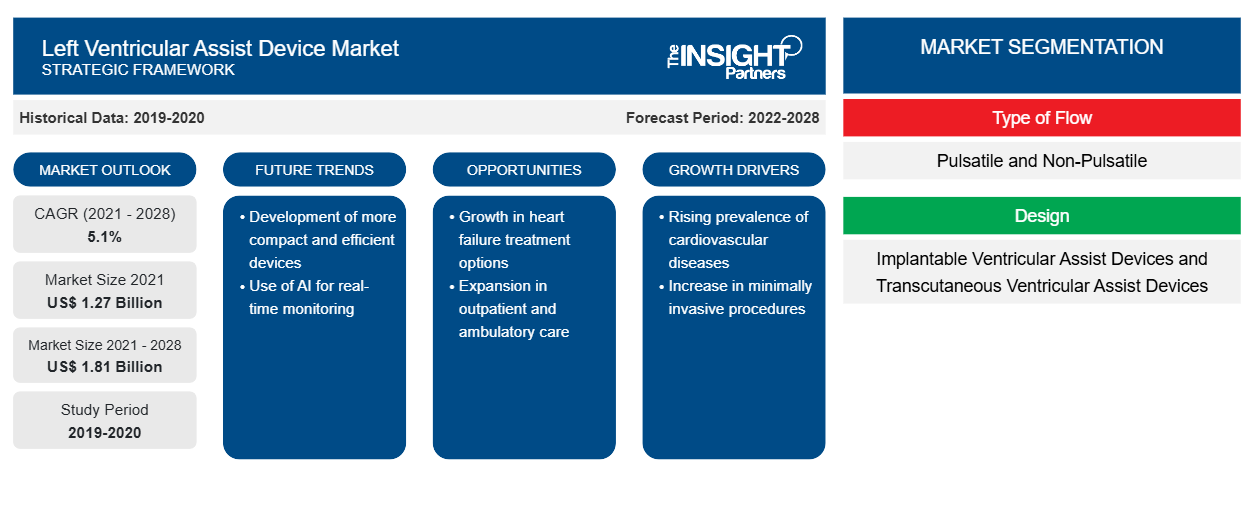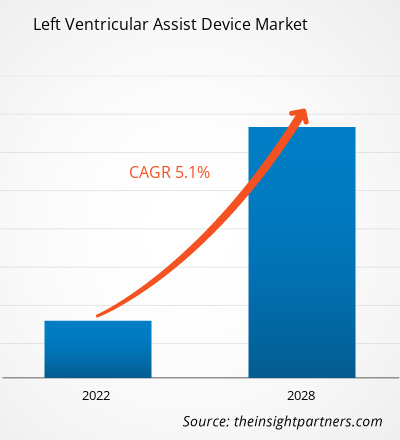[Rapporto di ricerca] Si prevedeva che il mercato dei dispositivi di assistenza ventricolare sinistra avrebbe raggiunto 1.272,08 milioni di dollari nel 2021 e si prevede che crescerà a un CAGR del 5,1% dal 2022 al 2028.
Il dispositivo di assistenza ventricolare sinistra aiuta il ventricolo sinistro del cuore a pompare il sangue al resto del corpo. È anche noto come dispositivo di supporto circolatorio meccanico che aiuta a mantenere una corretta circolazione sanguigna all'interno del corpo. L'aumento della prevalenza di disturbi cardiovascolari e insufficienza cardiaca insieme a un aumento significativo della popolazione geriatrica e obesa guida la crescita del mercato dei dispositivi di assistenza ventricolare sinistra . Tuttavia, i crescenti richiami di prodotti e le complicazioni associate ai dispositivi di assistenza ventricolare sinistra ostacolano la crescita del mercato.
Il rapporto offre approfondimenti e analisi approfondite del mercato dei dispositivi di assistenza ventricolare sinistra, sottolineando vari parametri come tendenze di mercato, progressi tecnologici, dinamiche di mercato e analisi del panorama competitivo dei principali attori del mercato globale. Include anche l'impatto della pandemia di COVID-19 sul mercato in tutte le regioni. A causa della pandemia di COVID-19, molte autorità sanitarie si sono concentrate sulle cure correlate alla pandemia. Hanno evitato il contatto umano a causa della crescente trasmissione e della pressione sulle risorse sanitarie posticipando interventi chirurgici elettivi, sospendendo ambulatori e triagendo i dipendenti coinvolti nelle cure urgenti. Inoltre, molti paesi hanno imposto restrizioni all'accesso del personale non clinico alla struttura e agli ospiti. Inoltre, si è verificato un aumento della prevalenza di condizioni cardiovascolari tra i pazienti COVID-19, che ha ulteriormente creato la domanda di dispositivi di assistenza ventricolare sinistra, con conseguente crescita del mercato. Le recenti linee guida COVID-19 per gli operatori sanitari hanno suggerito di concentrarsi sulle cure urgenti e sui casi di triage per posticipare interventi chirurgici elettivi e appuntamenti in clinica, con una transizione all'assistenza virtuale quando appropriato.
Personalizza questo report in base alle tue esigenze
Riceverai la personalizzazione gratuita di qualsiasi report, comprese parti di questo report, o analisi a livello nazionale, pacchetto dati Excel, oltre a usufruire di grandi offerte e sconti per start-up e università
- Scopri le principali tendenze di mercato in questo rapporto.Questo campione GRATUITO includerà analisi di dati che spaziano dalle tendenze di mercato alle stime e alle previsioni.
Inoltre, le aziende produttrici di molti dispositivi di assistenza ventricolare sinistra stanno rispondendo alle emergenze attraverso varie strategie come la produzione di DPI per gli operatori sanitari, la distribuzione di farmaci e altre attività. Inoltre, a novembre 2020, Medtronic e la fondazione Medtronic hanno impegnato il supporto finanziario di 3,8 milioni di dollari a livello globale per fornire supporto agli operatori sanitari in termini di cibo, supporto operativo, supporto per la salute mentale, kit DPI e altro. Pertanto, la pandemia ha avuto un impatto negativo a breve termine sul mercato dei dispositivi di assistenza ventricolare sinistra.
Il mercato dei dispositivi di assistenza ventricolare sinistra è segmentato in base al tipo di flusso, design, applicazione e geografia. Per regione, il mercato è segmentato in Nord America, Europa, Asia Pacifico, Medio Oriente e Africa e Sud e Centro America.
Approfondimenti di mercato
Aumento dell'incidenza di malattie e procedure target
Secondo l'Organizzazione Mondiale della Sanità (OMS), le malattie cardiovascolari (CVD) sono una delle principali cause di morte in tutto il mondo. Alcuni dei principali fattori che stanno aumentando la prevalenza di CVD e ictus sono la storia familiare, l'etnia e l'età. La prevalenza di CVD sta aumentando anche a causa del consumo di tabacco; pressione alta (ipertensione); colesterolo alto; mancanza di esercizio fisico; dieta non sana; consumo eccessivo di alcol; e malattie come dislipidemia, obesità e diabete. Secondo l'American Heart Association, circa il 41,4% degli adulti negli Stati Uniti soffrirà di ipertensione entro il 2030 (un aumento dell'8,4% rispetto al 2012). L'organizzazione stima inoltre che il costo globale delle malattie cardiovascolari raggiungerà i 1.044 miliardi di dollari entro il 2030, rispetto agli 863 miliardi di dollari del 2010. Inoltre, secondo le stime dell'OMS, i decessi dovuti alle malattie cardiovascolari in tutto il mondo aumenteranno da circa 17,9 milioni nel 2016 a 23,6 milioni entro il 2030. Il rapporto di Emory Healthcare afferma che gli Stati Uniti hanno registrato circa 5 milioni di casi di insufficienza congestizia nel 2022 e circa 550.000 nuovi casi sono stati diagnosticati ogni anno nel paese. Inoltre, il paese segnala circa 287.000 decessi dovuti a insufficienza cardiaca ogni anno.
Secondo Temple Health, il 70,9% dei pazienti ha ricevuto trapianti di cuore entro un anno e la lista d'attesa media più breve è stata del 55,2% negli Stati Uniti nel 2021. L'aumento della lista d'attesa per il trapianto di cuore a livello globale ha spinto l'uso di dispositivi di assistenza ventricolare sinistra (LVAD) per i pazienti con insufficienza cardiaca allo stadio terminale per aumentare la frazione di eiezione e prevenire l'insufficienza d'organo. Pertanto, la crescente prevalenza di CVD e insufficienza cardiaca e la lunga lista d'attesa per un trapianto di cuore spingono l'adozione di LVAD, che guida la crescita del mercato dei dispositivi di assistenza ventricolare sinistra.
Tipo di informazioni basate sul flusso
In base al tipo di flusso, il mercato globale dei dispositivi di assistenza ventricolare sinistra è segmentato in pulsatile e non pulsatile. Nel 2021, il segmento non pulsatile ha rappresentato una quota di mercato maggiore e si prevede che registrerà un CAGR più elevato nel mercato nel periodo 2022-2028.
Approfondimenti basati sulla progettazione
In base al design, il mercato dei dispositivi di assistenza ventricolare sinistra è diviso in dispositivi di assistenza ventricolare impiantabili e dispositivi di assistenza ventricolare transcutanei. Il segmento dei dispositivi di assistenza ventricolare impiantabili ha detenuto una quota di mercato maggiore nel 2021 e si prevede che registrerà un CAGR più elevato durante il periodo di previsione.
Approfondimenti basati sulle applicazioni
In base all'applicazione, il mercato dei dispositivi di assistenza ventricolare sinistra è segmentato in terapia di destinazione, ponte al trapianto, ponte alla candidatura e ponte al recupero. Il segmento della terapia di destinazione ha detenuto la quota di mercato maggiore nel 2021 e si prevede che registrerà il CAGR più elevato durante il periodo di previsione.
Gli operatori del mercato dei dispositivi di assistenza ventricolare sinistra adottano strategie organiche come lanci di prodotti, approvazioni di prodotti ed espansione per espandere la propria presenza e il portafoglio di prodotti in tutto il mondo e soddisfare la crescente domanda. A giugno 2020, Abiomed ha annunciato l'approvazione della Food and Drug Administration (FDA) statunitense per la sua domanda di esenzione per dispositivi sperimentali per l'avvio di uno studio di fattibilità precoce con una sperimentazione first-in-human per la pompa cardiaca Impella ECP.
Approfondimenti basati sulla geografia
In base alla geografia, il mercato dei dispositivi di assistenza ventricolare sinistra è segmentato in Nord America (Stati Uniti, Canada e Messico), Europa (Francia, Germania, Regno Unito, Spagna, Italia e resto d'Europa), Asia Pacifico (Cina, India, Giappone, Australia, Corea del Sud e resto dell'APAC), Medio Oriente e Africa (Arabia Saudita, Emirati Arabi Uniti, Sudafrica e resto dell'area MEA) e America meridionale e centrale (Brasile, Argentina e resto dell'America meridionale e centrale).
Approfondimenti regionali sul mercato dei dispositivi di assistenza ventricolare sinistra
Le tendenze regionali e i fattori che influenzano il mercato dei dispositivi di assistenza ventricolare sinistra durante il periodo di previsione sono stati ampiamente spiegati dagli analisti di Insight Partners. Questa sezione discute anche i segmenti e la geografia del mercato dei dispositivi di assistenza ventricolare sinistra in Nord America, Europa, Asia Pacifico, Medio Oriente e Africa e America meridionale e centrale.

- Ottieni i dati specifici regionali per il mercato dei dispositivi di assistenza ventricolare sinistra
Ambito del rapporto di mercato sui dispositivi di assistenza ventricolare sinistra
| Attributo del report | Dettagli |
|---|---|
| Dimensioni del mercato nel 2021 | 1,27 miliardi di dollari USA |
| Dimensioni del mercato entro il 2028 | 1,81 miliardi di dollari USA |
| CAGR globale (2021 - 2028) | 5,1% |
| Dati storici | 2019-2020 |
| Periodo di previsione | 2022-2028 |
| Segmenti coperti | Per tipo di flusso
|
| Regioni e Paesi coperti | America del Nord
|
| Leader di mercato e profili aziendali chiave |
|
Densità dei player del mercato dei dispositivi di assistenza ventricolare sinistra: comprendere il suo impatto sulle dinamiche aziendali
Il mercato dei dispositivi di assistenza ventricolare sinistra sta crescendo rapidamente, spinto dalla crescente domanda degli utenti finali dovuta a fattori quali l'evoluzione delle preferenze dei consumatori, i progressi tecnologici e una maggiore consapevolezza dei vantaggi del prodotto. Con l'aumento della domanda, le aziende stanno ampliando le loro offerte, innovando per soddisfare le esigenze dei consumatori e capitalizzando sulle tendenze emergenti, il che alimenta ulteriormente la crescita del mercato.
La densità degli operatori di mercato si riferisce alla distribuzione di aziende o società che operano in un particolare mercato o settore. Indica quanti concorrenti (operatori di mercato) sono presenti in un dato spazio di mercato in relazione alle sue dimensioni o al valore di mercato totale.
Le principali aziende che operano nel mercato dei dispositivi di assistenza ventricolare sinistra sono:
- ABIOMED Inc
- Laboratori Abbott
- Medtronica SpA
- Società Livanova
- Cuore Jarvik Inc
Disclaimer : le aziende elencate sopra non sono classificate secondo un ordine particolare.

- Ottieni la panoramica dei principali attori del mercato dei dispositivi di assistenza ventricolare sinistra
Approfondimenti basati sull'azienda
ABIOMED Inc, Abbott Laboratories, Medtronic Plc, LivaNova Plc, Jarvik Heart Inc, Terumo Corp, Berlin Heart GmbH, BiVACOR Inc, Evaheart Inc e BioVentrix Inc. sono tra le aziende leader che operano nel mercato dei dispositivi di assistenza ventricolare sinistra.
- Analisi storica (2 anni), anno base, previsione (7 anni) con CAGR
- Analisi PEST e SWOT
- Valore/volume delle dimensioni del mercato - Globale, regionale, nazionale
- Industria e panorama competitivo
- Set di dati Excel



Report Coverage
Revenue forecast, Company Analysis, Industry landscape, Growth factors, and Trends

Segment Covered
This text is related
to segments covered.

Regional Scope
North America, Europe, Asia Pacific, Middle East & Africa, South & Central America

Country Scope
This text is related
to country scope.
Domande frequenti
Increasing incidence of target diseases and procedures and growing geriatric population are the most significant factors responsible for the overall market growth.
Based on type of flow segment, the non-pulsatile segment took the forefront leaders in the worldwide market by accounting largest share in 2021 and is expected to continue to do so till the forecast period.
Based on the application, destination therapy segment took the forefront leaders in the worldwide market by accounting largest share in 2021.
Implantable ventricular assist device segment dominated the global left ventricular assist device market and accounted for the largest market share during the forecast period of 2022-2028.
Left ventricular assist device is a mechanical pump implanted in heart failure. This device helps the left ventricle of the heart in pumping blood to the rest of the body. It is also known as a mechanical circulatory support device that helps in maintaining proper blood circulation within the body.
Global left ventricular assist device market is segmented by region into North America, Europe, Asia Pacific, Middle East & Africa, and South & Central America. In North America, the U.S. is the largest market for left ventricular assist device market. According to the Centers for Disease Control and Prevention (CDC), ~6.2 million adults in the US suffer from heart failure, and it was the cause of death of ~697,000 people in 2018. According to the data provided by the American Heart Association Inc., ~1 million new heart failure cases are registered annually in the US, and more than 8 million people are estimated to suffer from heart failure by 2030. According to the Health Research Funding Organization, ~555,000 people were diagnosed with the beginning stages of heart failure in the US in 2021, and ~300,000 patients in the US qualify for a left ventricular assist device (LVAD) because of their terminal heart conditions. Cardiovascular diseases (CVDs) generally lead to heart failure or terminal heart disease, which bolsters the demand for LVADs that ensure proper heart functioning. Such aforementioned facto acts as a standalone factor responsible for the overall market growth of left ventricular assist device in the US during the forecast period of 2022-2028.
ABIOMED Inc, Abbott Laboratories, Medtronic Plc, LivaNova Plc, Jarvik Heart Inc, Terumo Corp, Berlin Heart GmbH, BiVACOR Inc, Evaheart Inc, and BioVentrix Inc, and among others are among the leading companies operating in the left ventricular assist device market.
Trends and growth analysis reports related to Life Sciences : READ MORE..
The List of Companies - Left Ventricular Assist Device Market
- ABIOMED Inc
- Abbott Laboratories
- Medtronic Plc
- LivaNova Plc
- Jarvik Heart Inc
- Terumo Corp
- Berlin Heart GmbH
- BiVACOR Inc
- Evaheart Inc
- BioVentrix Inc
The Insight Partners performs research in 4 major stages: Data Collection & Secondary Research, Primary Research, Data Analysis and Data Triangulation & Final Review.
- Data Collection and Secondary Research:
As a market research and consulting firm operating from a decade, we have published and advised several client across the globe. First step for any study will start with an assessment of currently available data and insights from existing reports. Further, historical and current market information is collected from Investor Presentations, Annual Reports, SEC Filings, etc., and other information related to company’s performance and market positioning are gathered from Paid Databases (Factiva, Hoovers, and Reuters) and various other publications available in public domain.
Several associations trade associates, technical forums, institutes, societies and organization are accessed to gain technical as well as market related insights through their publications such as research papers, blogs and press releases related to the studies are referred to get cues about the market. Further, white papers, journals, magazines, and other news articles published in last 3 years are scrutinized and analyzed to understand the current market trends.
- Primary Research:
The primarily interview analysis comprise of data obtained from industry participants interview and answers to survey questions gathered by in-house primary team.
For primary research, interviews are conducted with industry experts/CEOs/Marketing Managers/VPs/Subject Matter Experts from both demand and supply side to get a 360-degree view of the market. The primary team conducts several interviews based on the complexity of the markets to understand the various market trends and dynamics which makes research more credible and precise.
A typical research interview fulfils the following functions:
- Provides first-hand information on the market size, market trends, growth trends, competitive landscape, and outlook
- Validates and strengthens in-house secondary research findings
- Develops the analysis team’s expertise and market understanding
Primary research involves email interactions and telephone interviews for each market, category, segment, and sub-segment across geographies. The participants who typically take part in such a process include, but are not limited to:
- Industry participants: VPs, business development managers, market intelligence managers and national sales managers
- Outside experts: Valuation experts, research analysts and key opinion leaders specializing in the electronics and semiconductor industry.
Below is the breakup of our primary respondents by company, designation, and region:

Once we receive the confirmation from primary research sources or primary respondents, we finalize the base year market estimation and forecast the data as per the macroeconomic and microeconomic factors assessed during data collection.
- Data Analysis:
Once data is validated through both secondary as well as primary respondents, we finalize the market estimations by hypothesis formulation and factor analysis at regional and country level.
- Macro-Economic Factor Analysis:
We analyse macroeconomic indicators such the gross domestic product (GDP), increase in the demand for goods and services across industries, technological advancement, regional economic growth, governmental policies, the influence of COVID-19, PEST analysis, and other aspects. This analysis aids in setting benchmarks for various nations/regions and approximating market splits. Additionally, the general trend of the aforementioned components aid in determining the market's development possibilities.
- Country Level Data:
Various factors that are especially aligned to the country are taken into account to determine the market size for a certain area and country, including the presence of vendors, such as headquarters and offices, the country's GDP, demand patterns, and industry growth. To comprehend the market dynamics for the nation, a number of growth variables, inhibitors, application areas, and current market trends are researched. The aforementioned elements aid in determining the country's overall market's growth potential.
- Company Profile:
The “Table of Contents” is formulated by listing and analyzing more than 25 - 30 companies operating in the market ecosystem across geographies. However, we profile only 10 companies as a standard practice in our syndicate reports. These 10 companies comprise leading, emerging, and regional players. Nonetheless, our analysis is not restricted to the 10 listed companies, we also analyze other companies present in the market to develop a holistic view and understand the prevailing trends. The “Company Profiles” section in the report covers key facts, business description, products & services, financial information, SWOT analysis, and key developments. The financial information presented is extracted from the annual reports and official documents of the publicly listed companies. Upon collecting the information for the sections of respective companies, we verify them via various primary sources and then compile the data in respective company profiles. The company level information helps us in deriving the base number as well as in forecasting the market size.
- Developing Base Number:
Aggregation of sales statistics (2020-2022) and macro-economic factor, and other secondary and primary research insights are utilized to arrive at base number and related market shares for 2022. The data gaps are identified in this step and relevant market data is analyzed, collected from paid primary interviews or databases. On finalizing the base year market size, forecasts are developed on the basis of macro-economic, industry and market growth factors and company level analysis.
- Data Triangulation and Final Review:
The market findings and base year market size calculations are validated from supply as well as demand side. Demand side validations are based on macro-economic factor analysis and benchmarks for respective regions and countries. In case of supply side validations, revenues of major companies are estimated (in case not available) based on industry benchmark, approximate number of employees, product portfolio, and primary interviews revenues are gathered. Further revenue from target product/service segment is assessed to avoid overshooting of market statistics. In case of heavy deviations between supply and demand side values, all thes steps are repeated to achieve synchronization.
We follow an iterative model, wherein we share our research findings with Subject Matter Experts (SME’s) and Key Opinion Leaders (KOLs) until consensus view of the market is not formulated – this model negates any drastic deviation in the opinions of experts. Only validated and universally acceptable research findings are quoted in our reports.
We have important check points that we use to validate our research findings – which we call – data triangulation, where we validate the information, we generate from secondary sources with primary interviews and then we re-validate with our internal data bases and Subject matter experts. This comprehensive model enables us to deliver high quality, reliable data in shortest possible time.


 Ottieni un campione gratuito per questo repot
Ottieni un campione gratuito per questo repot